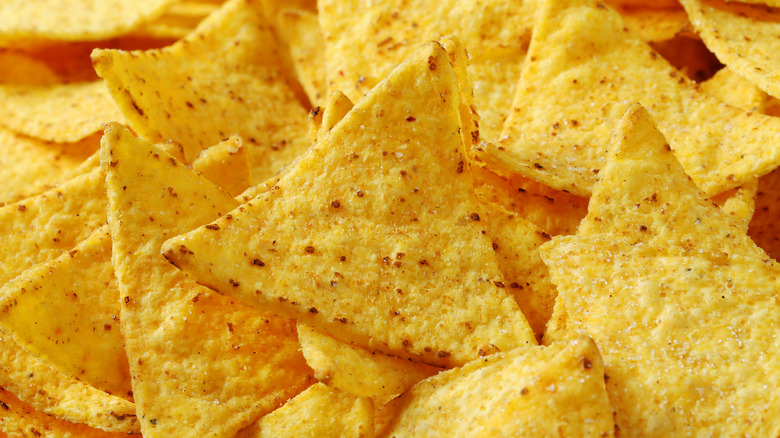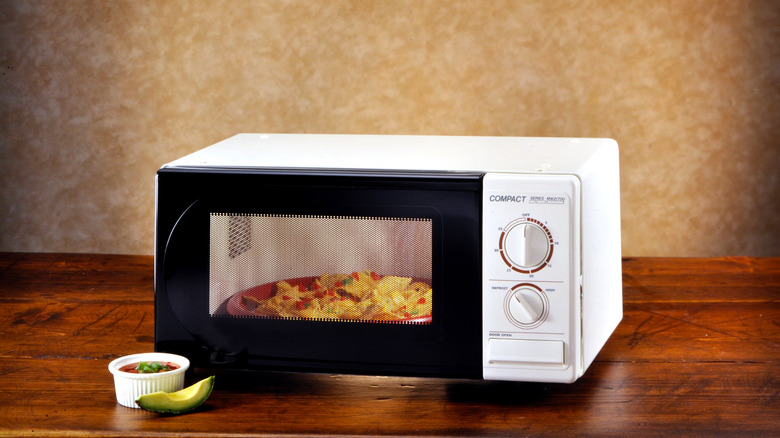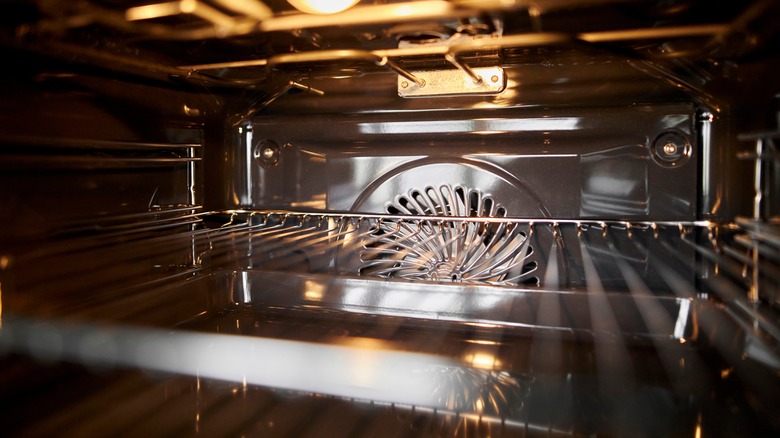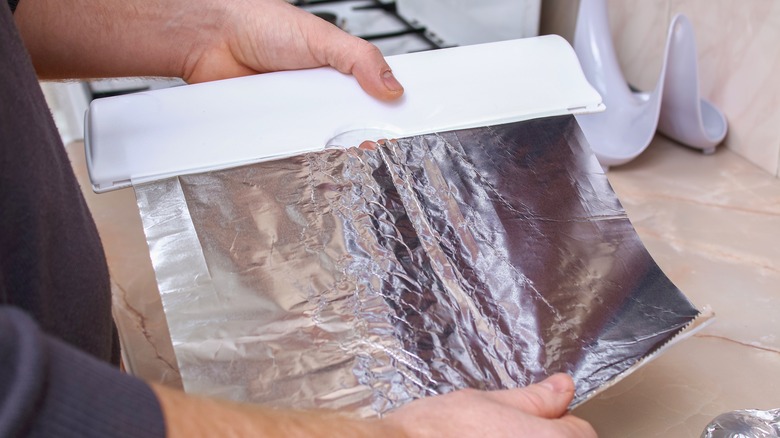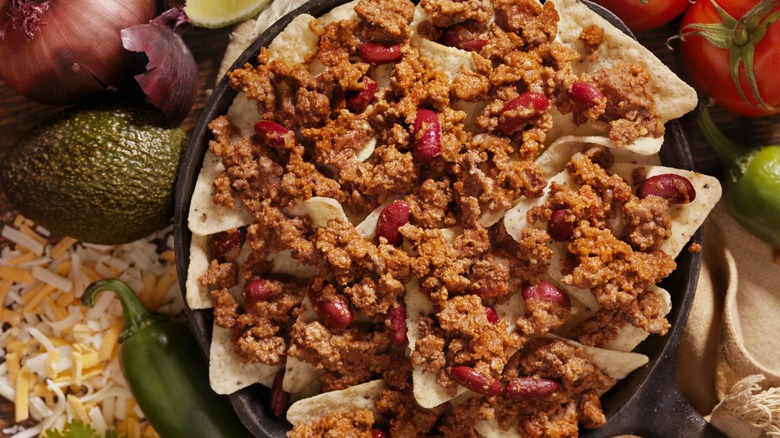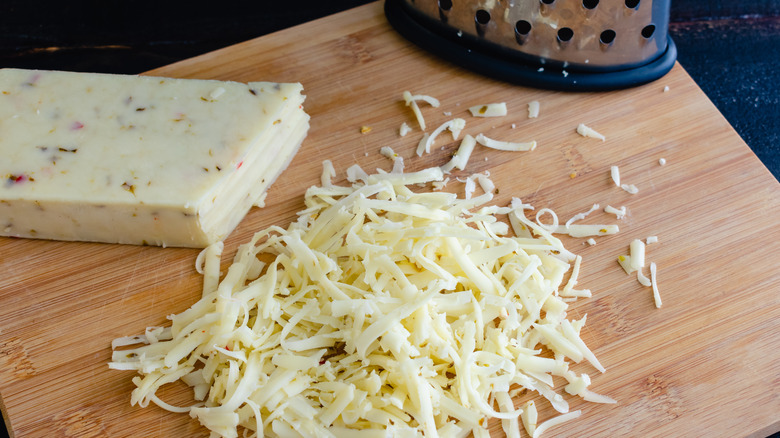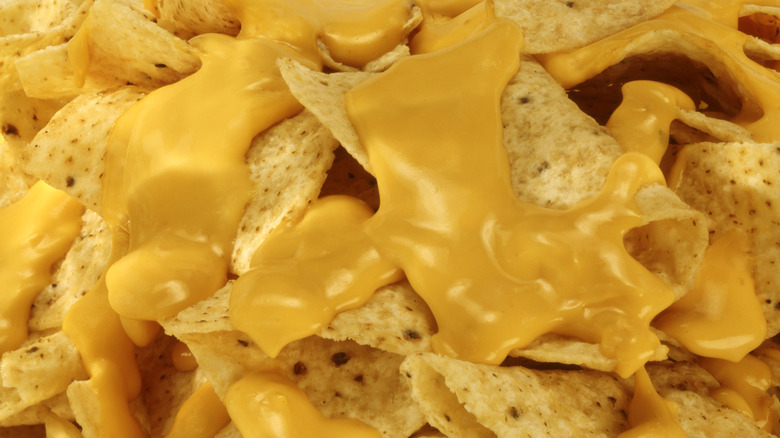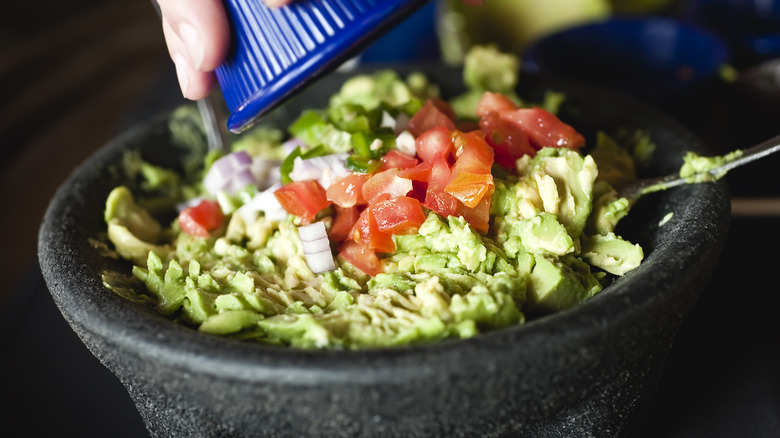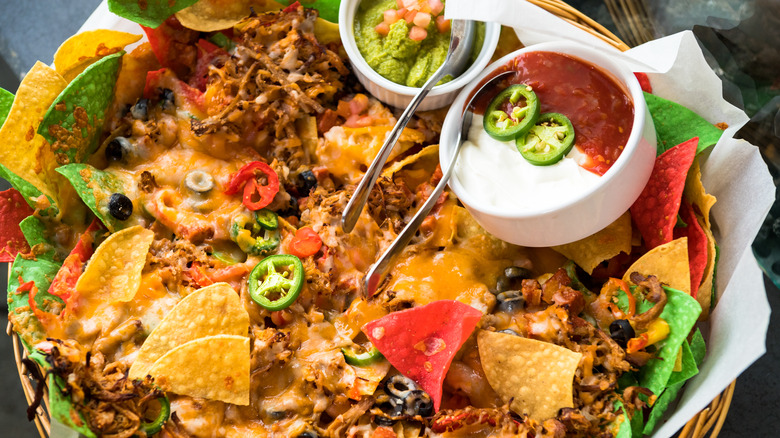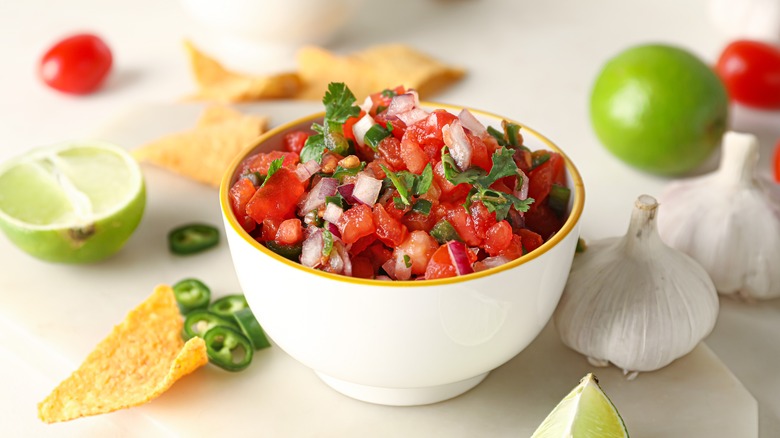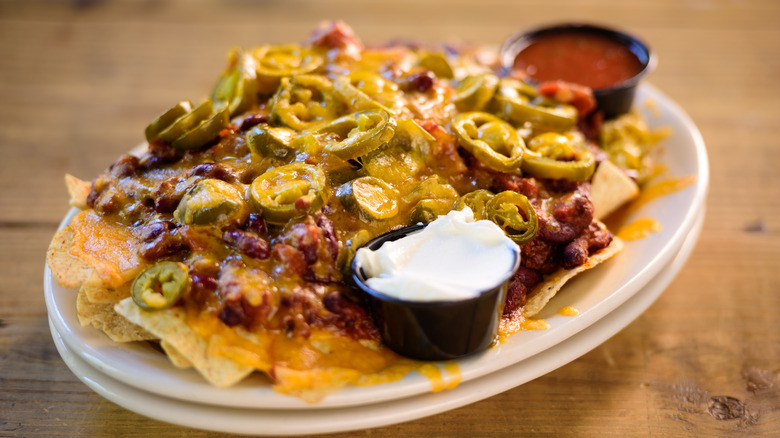You've Been Making Homemade Nachos Wrong This Entire Time
Making homemade nachos is an art and a science. In fact, there is real science behind why we've come to eat foods like nachos, chicken wings, and pizza as part of Super Bowl tradition and other celebrations. According to author and neuroscientist Rachel Herz, fatty and high-carb foods make our brains and bodies feel good. This can heighten the rush of your team winning and numb the pain of a Super Bowl loss. Regardless of what's on the TV, though, it isn't a party without nachos and we've always found making your own to be the best bet. If you can do it right, that is.
Nachos are a game-day favorite that can be cheaper than wings and pizza, as well as easier to make at home if you know what you're doing. Unfortunately, nachos are also easy to mess up as hundreds of internet posts and videos will tell you. When it comes to making nachos at home there are definite Dos and Don'ts. Here's what to avoid when making homemade nachos and what to do instead.
Mistake: Using the wrong chips
Chips are the literal and figurative base of any good plate of nachos. When it comes to nacho chips, you are looking for something sturdy that will hold up under toppings like beans, meat, guacamole, sour cream, and of course lots of melty cheese. So, how do you know what makes a good nacho chip and what doesn't?
According to professional chef and YouTuber Andrew Rea, you want a sturdy chip that is salty and oily, and that will hold up under the pressure of the toppings. He recommends you avoid flavored options like Doritos and stick with a plain tortilla chip. Thin chips like Xochitl Mexican-style tortilla chips are closer to what you want in terms of flavor, but the texture is all wrong. If you can't scoop up a nice pile of guac or salsa with a chip without it breaking, it's not sturdy enough for nachos. Andrew Rea recommended the Hola Nola Authentic tortilla chips, but if you've got your own preferred brand, just be sure that it's a thick, salted corn chip and you'll be good to go!
Mistake: Microwaving your nachos
Microwaves aren't just for frozen meals. They can be a great kitchen hack, whether you are using them to quickly cook a potato or even bake an easy mug cake. For nachos, though, we don't recommend going this route.
According to food writer Molly Watson, using the microwave to heat up nachos will kill the cheese. Putting nachos in the microwave for too long will result in a crusty, cardboard-y texture in your cheese. Don't put them in long enough and your cheese will barely get melted. Ultimately, if you try to microwave your nachos, you will soon find that both of these negatives can be simultaneously true. Around the edges of your plate, the cheese will be cooked beyond recognition while your nachos are still cold in the middle. Instead, achieve the perfectly crispy yet gooey cheese by popping your nachos in the oven, or even a toaster oven if you have one that is large enough to fit the entire dish.
Mistake: Setting the oven to bake
Every component of your nachos should be safe and ready to eat before you warm them up and melt the cheese. If you are putting raw meat on your nachos you've already messed up. In order to make perfect nachos, you shouldn't even use the bake setting on your oven at all. Use the broiler instead.
It should only take a couple of minutes in the broiler set on high for your cheese to melt and your nachos to heat up all the way through. Naturally, such a quick cook time means you need to be watching those suckers like a hawk. If you've tried broiling and find the high setting crisps up the corners of your chips too fast or even burns them, then remember you can always turn your boiler to low. It will take about three or four times as long to melt the cheese and get everything nice and toasty, but it's still a more reliable option than baking your nachos.
Mistake: Placing chips directly on the baking sheet
While it might seem like the best idea to grease up your baking sheet or tray and then load in your nachos, it's not. You should be taking this vital step in between. Trust us, future you will thank current you for listening.
Instead of placing your chips directly on your tray, first lay down a layer of foil or parchment paper. We recommend spraying a sheet of aluminum foil with cooking spray in order to prevent the chips from sticking to the bottom. This will help you avoid a long, messy cleanup later and you won't have to waste time scrubbing bits of crusted cheese off your favorite baking tray. Once the nachos have been devoured or transferred to a container for leftovers you can simply just toss the piece of foil straight into the garbage. Boom, that's half of the clean-up from dinner done and dusted.
Mistake: Layering your nachos unevenly
The worst thing you can find on a plate of nachos (barring any kitchen catastrophes) is a naked chip. If you dump a full bag of chips onto a pan or baking sheet and don't put any effort into making even layers, you are going to end up with a bunch of plain chips once you reach the bottom of your nachos. Piling nachos up too high can make it so only the first layer of chips gets toppings and the rest are left with dregs.
To ensure everyone at your Super Bowl party gets every delicious component in each bite, you will want to spread your chips evenly. The same goes for toppings, which you will want to distribute evenly across the chips, making sure each one has a little something.
If you need to add another layer on top of this, that's fine, just make sure you continue with your even spread and keep the ratios the same. Yes, lots of toppings can be good and structurally intact. Just look to Guy Fieri's layering strategy for his colossal tower of Trash Can Nachos to find the best way to stack nachos a mile high.
Mistake: Using cheese that doesn't melt
Getting the right cheese is paramount to a good nacho. It might just be the most important part. This means there are some things you will want to avoid when shopping for nacho cheeses.
The first big no-no is buying already shredded cheese. Due to preservative agents like potato starch and natamycin added to bagged shredded cheese during production, it doesn't melt as evenly as if you shredded it off a block yourself. It's worth the time and effort to grate your cheese by hand. You'll also want to avoid hard cheeses like parmesan since when they melt they tend to separate. Soft acid-set cheeses like Ricotta or a goat's milk cheese won't work either since they don't melt at all when heated.
Good melty block cheeses for nachos most commonly include jack (or pepper jack for some extra heat) or cheddar. These two cheeses are the most reliable in terms of melting and the flavors complement nacho toppings quite well. We've found in our experience making nachos topped with a queso fresco or similar crumbly cheese is an underrated way to up your nacho cheese game. Speaking of nacho cheese, you also have the option to buy or make your own cheese dip — although we wouldn't recommend the former if your goal is to make especially tasty and high-quality nachos.
Mistake: Using canned nacho cheese dip
If you want a thick, gooey, cheesy sauce for your nachos, we can't blame you. What we can do is advise that you skip out on using the cheese dip in a jar from the chip aisle. We are looking at you, Tostitos Nacho Cheese Dip.
If you want a gooey cheese sauce, the best option is to make your own. Cheeses we've already mentioned like jack and cheddar should be your starting point for making a delicious queso from home. Try adding aromatics like garlic and onion or a jalepeño pepper for heat if you want to really get the party started. And don't forget the one special ingredient that will make your nacho cheese shine — literally.
The secret ingredient to making a perfect nacho queso is sodium citrate. This form of salt is made from citric acid and has properties that help to keep your cheese mixture homogeneous and melty. This secret ingredient will keep your queso from separating or changing texture, even if you leave it sitting out for hours. This uncommon kitchen ingredient can be found on Amazon or at some specialty stores.
Mistake: Using store-bought guacamole
The problem with avocados is oxidation. This happens immediately after the green insides are exposed to oxygen, and leads them to turn a brown, unappealing color. That means when you buy pre-made guacamole from the grocery store it often includes ascorbic acid as an additive to keep its color. A synthetic source of Vitamin C, ascorbic acid is usually made from bioengineered (previously called GMO) corn and other chemical compounds. It is more nutritious and preferable to get your Vitamin C from a more natural source, like a fresh lime for example.
It's easier, healthier, and often cheaper to make guac from scratch. It will be fresher than store-bought since you will be all using ingredients you just picked up at the store. One of the big ones is real lime juice, which many pre-packaged guacamoles don't use. You'll find brands like Sabra use lime juice concentrate instead of fresh lime juice, which makes a significant difference in the taste of guac. Overall, we can't recommend homemade guac highly enough. It's a do-able process for any seasoned home cook, no mortar and pestle required.
Mistake: Drowning your nachos in wet toppings
Even late into the game, it's shockingly easy to ruin a plate of once-perfect nachos. The most common mistake made after the chips and cheese come out of the oven is drowning the whole tray in toppings. It might seem like an aesthetically appealing choice, but artistically dolloping globs of guacamole, salsa, and sour cream atop your nachos is a recipe for sogginess. In less than 10 minutes, the top layer of your nachos will become a hot mess, as will your shirt when all the toppings slide right off your disintegrating chip.
Instead, we recommend serving your cold sauce toppings on the side. Having cups on the side allows everyone who loves those things to assemble their perfect bite and everyone who doesn't care for sour cream (for example) doesn't have to worry about it. It's a win-win for everyone involved in the nacho eating.
Alternatively, you can place the dollops of pico, guac, and sour cream around the edges of your tray. This will look nice and won't make all your chips soggy.
Mistake: Serving watery pico
Pico de gallo is one of the most essential nacho toppings. This fresh salsa typically features tomatoes, onions, cilantro, jalepeńo and lime juice. A good pico can be that fresh kick you need to really balance out the fatty, greasiness of the meat and cheese of the nachos. A bad pico, on the other hand, can overload your nachos with watery liquid and ruin all your hard work up to this point. Don't let that happen!
If you want to avoid having your nachos taste like pico water, you'll need to strain your salsa before setting it on top of your creation or in a serving cup. Onions and tomatoes are vegetables with a high water content, so the longer your pico sits the more juices it will exude. To serve the perfect plate of homemade, make sure you strain all this excess out before you serve your pico de gallo.
Mistake: Not heating your veggie toppings
We're not sure who needs to hear this, but there are some nacho toppings that obviously shouldn't be heated up. Common sense tells us not to put salsa, cilantro, sour cream, or guacamole in the oven. However, some cold toppings actually benefit from a little bit of time under the heat.
Toppings including onions, olives, or pickled jalapeños actually can and should go on top of your nachos before you put them under the broiler. With onions, for example, from just a couple minutes in the oven can extract a whole lot more flavor out of them than you would get from a raw onion. As heat is applied to vegetables like onions and peppers, the pectin content of the vegetable begins to break down. This will soften up your veggies and allow the natural sweetness in them to come through a bit more. Even broiling your onions for just a couple of minutes with your nachos is enough to give them a greater depth of flavor than raw onions could ever have.

